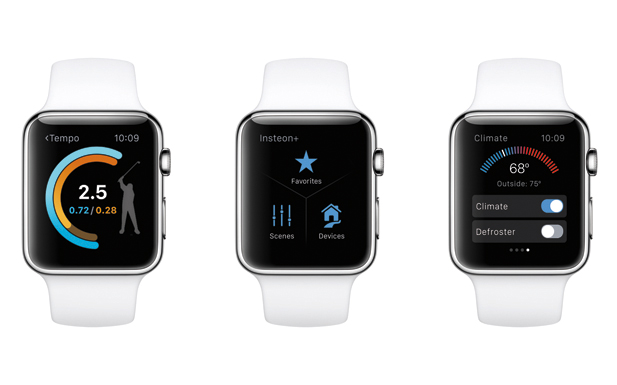Apple has previewed new software for its Watch and iPhone devices during its annual Worldwide Developers Conference.
watchOS 2 builds on the March launch of Apple Watch.
The software update brings new tools allowing developers to take advantage of hardware features when creating new apps, including the Apple Watch’s “Digital Crown”, heart rate sensor and haptic feedback engine.
New software APIs for video and audio playback have been made available to developers, Apple said.
The company has also introduced new features for end-users, including enhanced support for Apple Pay and third-party apps, as well as an “Activation Lock” allowing users to secure their device and prevent others from gaining access to it.
watchOS 2 also allows users to more quickly respond to messages using dictations or “Smart Replies”.
Support for Transit in Maps has been added, allowing users to view detailed information on public transport systems.
Meanwhile, Apple revealed that the Watch will start shipping to Italy, Mexico, Singapore, South Korea, Spain, Switzerland and Taiwan from June 26.
CSS Insight Analyst Geoff Blaber said: “The updates to the Apple Watch OS, particularly the support of native apps, address some of the early shortcomings around performance.
“Apple has listened to feedback and added a range of new capabilities that should greatly enhance the breadth and depth of apps.”
iOS 9 was also previewed at the San Fransisco event, bringing new APIs for developers, context-aware capabilities for Siri and additional maps functionality.
Amongst the tools offered for app developers include new profiles for Apple’s connected home app HomeKit, bringing support for motorised windows and shades, motion sensors and home security systems.
iOS 9 also offers support for auto manufacturers developing apps for Apple’s CarPlay system.
Within HealthKit, developers can now incorporate data points for reproductive health, UV exposure and water intake, Apple revealed.
Meanwhile, Siri now offers “contextual reminders”, Apple claimed, providing users with reminders based on time and location.
Much like watchOS 2, iOS 9 will also bring detailed transit information for metropolitan areas to the Maps app.
Security has also been bolstered for Apple’s latest OS, with two-factor authentication now built directly into iOS 9.
According to Blaber, while iOS 9 offers only an iterative step-up from iOS 8, the update puts Apple in a better position to compete with Google’s upcoming Android
[Read more: Google I/O brings Android M, payments system and soap-themed IoT]
He explained: “iOS 9 is an iterative release following two substantial updates in iOS7 and iOS8 to focus on stability and polish. Nonetheless, [updates to Siri] addresses a shortcoming in contextual information and seeks to take the fight to Google Now in both relevancy and ideology.
“HomeKit featured less prominently than expected but Apple is laying the foundations for wider support in future. Examples included a broader range of sensors, integration with Siri and support within Apple Watch apps.”
Apple’s upcoming iPhone OS will arrive in autumn alongside watchOS 2 and, presumably, new hardware from Cupertino.
Finally, the company revealed Apple Pay will land in the UK in July.



